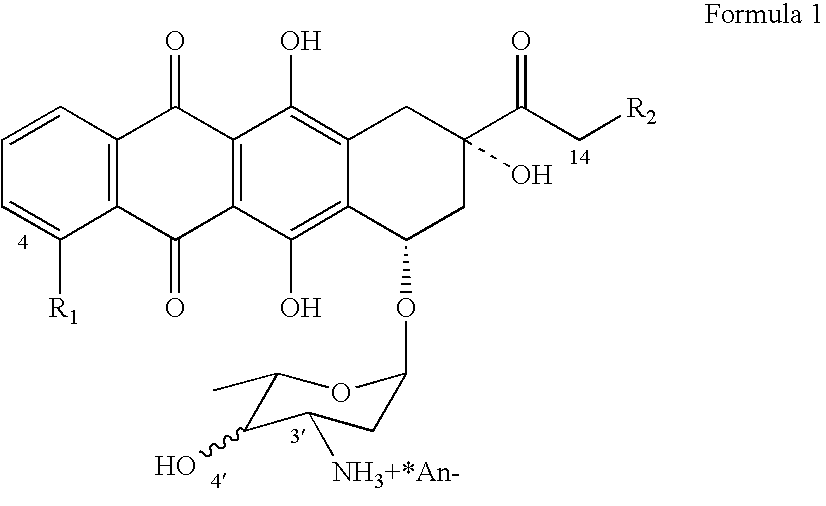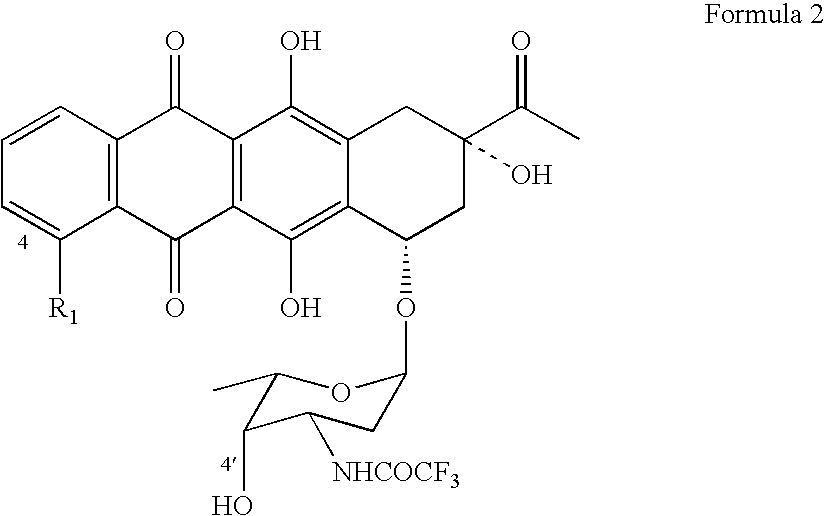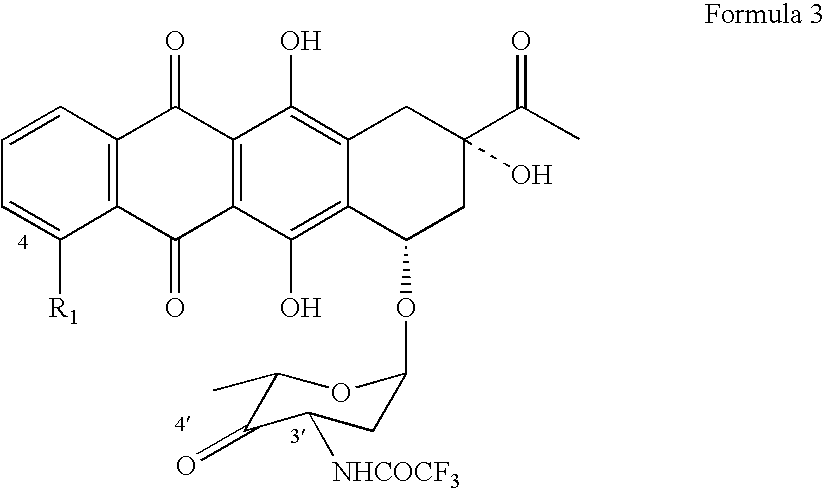Epimerization of 4'-C bond and modification of 14-CH3-(CO)-fragment in anthracyclin antibiotics
an anthracyclin and antibiotic technology, applied in the field of chemical methods used to produce anthracyclines, can solve the problems of increasing reducing the yield of products, and achieve the effects of reducing the number of synthetic stages, reducing the number of impurities, and simplifying extraction
- Summary
- Abstract
- Description
- Claims
- Application Information
AI Technical Summary
Benefits of technology
Problems solved by technology
Method used
Image
Examples
example 1
[0040] (a) 5 grams of daunorubicin (R1═OMe, R2 ═H ) is suspended in 200 ml of dichloromethane (DCM) and chilled to 0° C. While intensely stirring the suspension, drops of trifluoroacetic anhydride in DCM (7 ml: 15 ml) are slowly added over a period of 1 hour.
[0041] (b) Resulted mixture is kept at 0° C. for another 0.5 hours and then pored in 250 ml of distilled water and mixed with further separation of the organic layer.
[0042] (c) 200 ml of saturated solution of sodium bicarbonate is added to the resulted organic layer, and the mixture is left at room temperature, being intensely stirred, for 15-24 hours, in order to undergo hydrolysis 3′-N,4′-O-di-trifluoroacetyldaunomycin.
[0043] (d) After completion of hydrolysis (controlled according to HPLC), the organic layer is separated and subjected to evaporation under reduced pressure conditions until fully dry.
[0044] (e) After evaporation, 5 grams of N-trifluoroacetyldaunorubicin is produced with a purity 93% (Confirmed by HPLC).
[00...
example 2
[0046] (a) 5 ml of DMSO is dissolved in 100 ml of DCM and chilled down to −60° C. while being stirred. After that, 1 ml of oxalylchloride in 5 ml of DCM is added to the solution, which is then incubated at −60° C. for 40 minutes.
[0047] (b) 5 gram of N-trifluoroacetyldaunorubicin is dissolved in 50 ml of DCM and add to the reaction mixture over a 20-minute period, while maintaining the temperature in a −60±5° C. range. The reaction mixture is then incubated for 1 hour.
[0048] (c) 7 ml of triethylamine is added to the reaction mixture at a temperature≦−60° C. Total time of contact between the reaction mixture and triethylamine is 10 minutes.
[0049] (d) A solution of 5 ml of acetic acid in 10 ml of DCM is added to the reaction mixture and stirred for 2 minutes.
[0050] (e) Reaction mixture is then pored in a 300 ml of distilled water, stir and separate an organic layer. This step is repeated 3 times.
[0051] (f) Organic layer is evaporated in rotary evaporator under reduced pressure con...
example 3
[0054] (a) 4.7 grams of 4′keto-N-trifluoroacetyldaunorubicin is dissolved in 180 ml of tetrahydrofuran and, while stirring, 2.1 grams of sodium triacetylborohydride is added over a 40-minut period. While being agitated, the reaction mixture is incubated for 1 hour at a temperature range of 20±2° C.
[0055] (b) Reaction mass is then transfered into a mixture of 150 ml of DCM +300 ml of distilled water +2 ml of 1M hydrochloric acid, and stirred. Organic layer is separated and then washed twice with 300 ml aliquots of distilled water.
[0056] (c) After evaporation, 4.6 g of 4′epi-N-trifluoroacetyldaunorubicin is produced with a purity 79% (Confirmed by HPLC).
[0057] (d) Produced crude product then undergoes purification in preparative chromatograph. After evaporation of the eluate, 3.0 gram of 4′epi-N-trifluoroacetyldaunorubicin is produced with a purity 95% (Confirmed by HPLC).
PUM
| Property | Measurement | Unit |
|---|---|---|
| Temperature | aaaaa | aaaaa |
| Temperature | aaaaa | aaaaa |
| Temperature | aaaaa | aaaaa |
Abstract
Description
Claims
Application Information
 Login to View More
Login to View More - R&D
- Intellectual Property
- Life Sciences
- Materials
- Tech Scout
- Unparalleled Data Quality
- Higher Quality Content
- 60% Fewer Hallucinations
Browse by: Latest US Patents, China's latest patents, Technical Efficacy Thesaurus, Application Domain, Technology Topic, Popular Technical Reports.
© 2025 PatSnap. All rights reserved.Legal|Privacy policy|Modern Slavery Act Transparency Statement|Sitemap|About US| Contact US: help@patsnap.com



